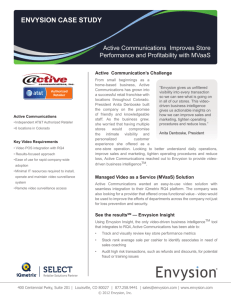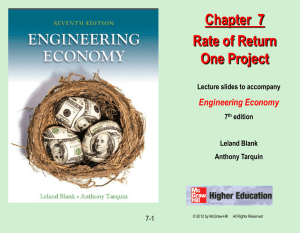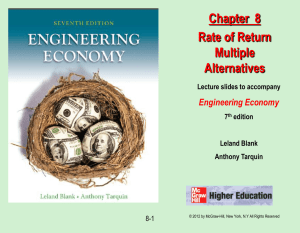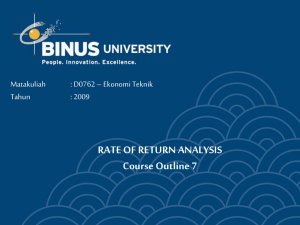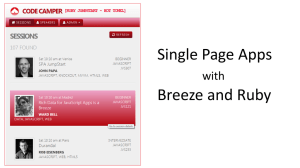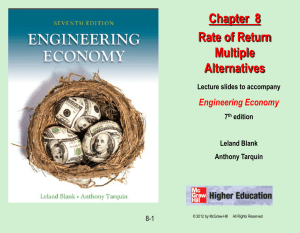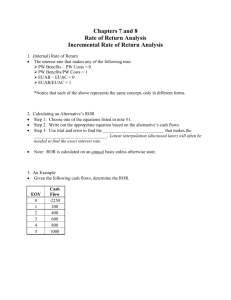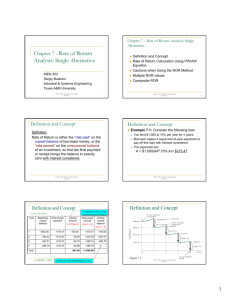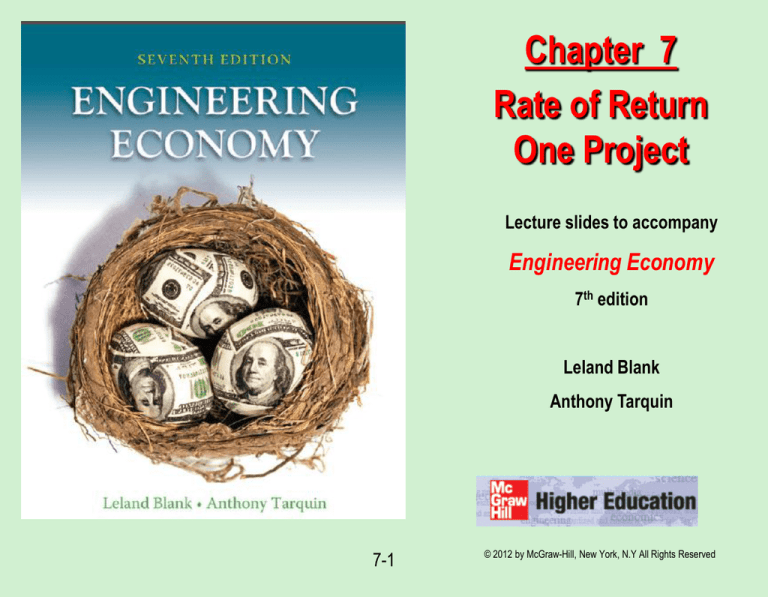
Chapter 7
Rate of Return
One Project
Lecture slides to accompany
Engineering Economy
7th edition
Leland Blank
Anthony Tarquin
7-1
© 2012 by McGraw-Hill, New York, N.Y All Rights Reserved
LEARNING OUTCOMES
1. Understand meaning of ROR
2. Calculate ROR from series of CFs
3. Understand difficulties of ROR
4. Determine multiple ROR values
5. Calculate EROR
6. Calculate r and i for bonds
7-2
© 2012 by McGraw-Hill, New York, N.Y All Rights Reserved
Interpretation of ROR
Rate paid on unrecovered balance of borrowed money
Equations can be written in terms of PW, FW, or AW
Usually involve trial and error solution
Numerical value can range from -100% to infinity
7-3
© 2012 by McGraw-Hill, New York, N.Y All Rights Reserved
ROR Calculation Using PW, FW or AW Relation
ROR is rate that makes PW, FW, or AW of CF exactly = 0
An investment of $20,000 in a certain machine will generate income of
$7000 per year for 3 years, at which time the machine can be sold for
$8000. If the company’s MARR is 15% per year, should it buy the machine?
Solution:: The ROR equation is:
0 = -20,000 + 7000(P/A,i,3) + 8000(P/F,i,3)
Solve for i by trial and error or Excel: i = 18.2% per year
Since i>MARR, the company should buy the machine
7-4
© 2012 by McGraw-Hill, New York, N.Y All Rights Reserved
Special Considerations for ROR
May get multiple i* values (discussed later)
i* assumes reinvestment of positive cash flows
was done at i* rate (may be unrealistic)
Incremental analysis necessary for multiple
alternative evaluations (discussed later)
7-5
© 2012 by McGraw-Hill, New York, N.Y All Rights Reserved
Multiple ROR Values
Multiple i* values may exist when there is more than one sign
change in net cash flow (CF). Such CF is called non-conventional
Two tests for multiple i* values:
Descarte’s rule of signs: total number of real i values
is ≤ the number of sign changes in net cash flow series
Norstrom’s criterion: if the cumulative cash flow starts off
negatively and has only one sign change, there is only one
positive root
7-6
© 2012 by McGraw-Hill, New York, N.Y All Rights Reserved
Example Multiple i* Values
Determine the maximum number of i* values for the cash flow shown below
Year
Expense
0
1
2
3
4
5
-12,000
-5,000
-6,000
-7,000
-8,000
-9,000
Income
Net cash flow
+ 3,000
+9,000
+15,000
+16,000
+8,000
-12,000
-2,000
+3,000
+8,000
+8,000
-1,000
Cumulative CF
-12,000
-14,000
-11,000
-3,000
+5,000
+4,000
Solution:
The cumulative cash flow begins
negatively with one sign change
The sign on the net cash flow changes
twice, indicating two possible i* values
Therefore, there is only one i* value( i* = 4.7%)
7-7
© 2012 by McGraw-Hill, New York, N.Y All Rights Reserved
Removing Multiple i* Values
Two approaches: (1) Modified ROR (MIRR)
(2) Return on Invested Capital (ROIC)
Two new interest rates to consider:
Investment rate ii – rate at which extra funds
are invested external to the project
Borrowing rate ib – rate at which funds are
borrowed from an external source to provide
funds to the project
7-8
© 2012 by McGraw-Hill, New York, N.Y All Rights Reserved
Modified ROR Approach (MIRR)
Four step Procedure:
Determine PW in year 0 of all negative CF at ib
Determine FW in year n of all positive CF at ii
Calculate modified ROR i’ by FW = PW(F/P,i’,n)
If i’ ≥ MARR, project is justified
7-9
© 2012 by McGraw-Hill, New York, N.Y All Rights Reserved
MIRR Example
For the NCF shown below, find the EROR by the MIRR method if
MARR = 9%, ib = 8.5%, and ii = 12%
Year
0
NCF +2000
Solution:
1
-500
2
-8100
3
+6800
PW0 = -500(P/F,8.5%,1) - 8100(P/F,8.5%,2)
= $-7342
FW3 = 2000(F/P,12%,3) + 6800
= $9610
PW0(F/P,i’,3) + FW3 = 0
-7342(1 + i’)3 + 9610 = 0
i’ = 0.939 (9.39%)
Since i’ > MARR of 9%, project is justified
7-10
© 2012 by McGraw-Hill, New York, N.Y All Rights Reserved
Return on Invested Capital Approach (ROIC)
Measure of how effectively project uses funds that remain internal to project
ROIC rate, i’’, is determined using net-investment procedure
Three step Procedure:
(1) Develop series of FW relations for each year t using:
Ft = Ft-1(1 + k) + NCFt
Where: k= ii if Ft-1>0 and k = i’’ if Ft-1<0
(2) Set future worth relation for last year n equal to 0 (i.e. Fn= 0) & solve for i’’
(3) If i’’ ≥ MARR, project is justified; otherwise, reject
7-11
© 2012 by McGraw-Hill, New York, N.Y All Rights Reserved
ROIC Example
For the NCF shown below, find the EROR by the ROIC method if
MARR = 9% and ii = 12%
Year
0
NCF +2000
1
-500
2
-8100
3
+6800
Solution:
Year 0: F0 = $+2000
Year 1: F1 = 2000(1.12) - 500 = $+1740
Year 2: F2 = 1740(1.12) - 8100 = $-6151
Year 3: F3 = -6151(1 + i’’) + 6800
F0 > 0; invest in year 1 at ii = 12%
F1 > 0; invest in year 2 at ii = 12%
F2 < 0; use i’’ for year 3
Set F3 = 0 and solve for i’’
-6151(1 + i’’) + 6800 = 0
i’’= 10.55%
Since i’’ > MARR of 9%, project is justified
7-12
© 2012 by McGraw-Hill, New York, N.Y All Rights Reserved
ROR of Bond Investment
Bond is IOU with face value (V), coupon rate (b), no. of payment periods/year (c),
dividend (I), and maturity date (n)
Where: I = Vb/c
General equation: 0 = -P + I(P/A,i*,nxc) + V(P/F,i*,nxc)
A $10,000 bond with 6% interest payable quarterly is for sale for $8000.
If the bond matures in 5 years, what is the ROR (a) per quarter (b) per year
Solution: (a) I = 10,000(0.06)/4 = $150 per quarter
ROR equation is: 0 = -8000 + 150(P/A,i*,20) + 10,000(P/F,i*,20)
By trial and error or Excel, i* = 2.8% per quarter
(b)
Nominal i* per year = 2.8(4) = 11.2% per year
Effective i* per year = (1 + 0.028)4 – 1 = 11.7% per year
7-13
© 2012 by McGraw-Hill, New York, N.Y All Rights Reserved
Summary of Important Points
ROR equations can be written in terms of PW, FW, or AW and
usually require trial and error solution
i* assumes reinvestment of positive cash flows at i* rate
More than 1 sign change in NCF may cause multiple i* values
Descarte’s rule of signs & Norstrom’s criterion useful when
multiple i* values are suspected
EROR can be calculated using MIRR or ROIC approaches
General equation for bonds is 0 = -P + I(P/A,i*,nxc) + V(P/F,i*,nxc)
7-14
© 2012 by McGraw-Hill, New York, N.Y All Rights Reserved

